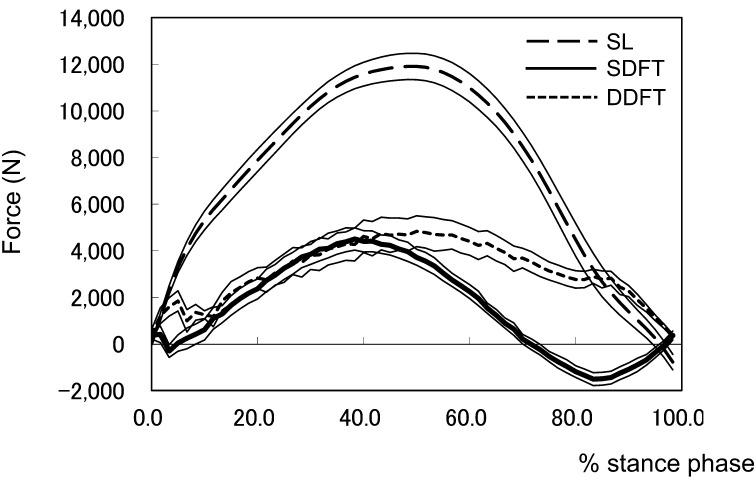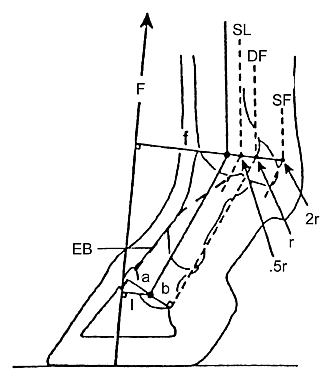
Biomechanical Rationale for Plantar Heel Extensions in the Management of Chronic Hindlimb Proximal Suspensory Desmopathy
Biomechanical Rationale for Plantar Heel Extensions in the Management of Chronic Hindlimb Proximal Suspensory Desmopathy
Caldwell M and Madden N. Scientific Horseshoeing Limited. 116, Newcastle Road, Talke, Staffordshire. ST71SA. Email info@hoofflix.com
Introduction
Chronic proximal suspensory ligament desmopathy (PSLD) in the hindlimb is frequently associated with overloading of the suspensory origin, particularly in horses with negative plantar angles, long toe–low heel conformation, and digit hyperextension during the stance phase [Turner, 2003; Sharp, 2022]. Therapeutic farriery strategies have evolved to address these biomechanical contributors directly.
Plantar heel extensions, applied via shoeing or wedge inserts, are used to alter the orientation of the hind digit relative to the ground, with the goal of reducing fetlock dorsiflexion and the associated tensile strain on the PSL during weight bearing.
Mechanical Basis of PSL Load During Locomotion
The PSL functions as a primary support structure for the metatarsophalangeal (fetlock) joint, acting to limit its hyperextension (dorsiflexion) during midstance and storing elastic energy for recoil during the push-off phase [Gillis et al., 1995; Robert et al., 2001]. During weight-bearing, fetlock dorsiflexion increases tension in the PSL, especially when:
The digit is excessively extended, as seen with negative plantar angles The heel is lowered relative to the toe, increasing the moment arm at the fetlock This load is compounded in the hindlimb by upright limb conformation, caudally shifted pelvic posture, or chronic postural compensation [Denoix et al., 2014].
Fig 1. Peak force (N) exerted on SDFT, DDFT and the Suspensory ligament (SL) during the stance phase
Biomechanical Effect of Plantar Heel Extensions Plantar heel extensions act to elevate the heel and increase the plantar angle of the hoof. This change has several biomechanical effects:
- Reduction in Fetlock Dorsiflexion. By artificially elevating the heel, the hoof contacts the ground in a more digitally flexed orientation. This decreases the fetlock’s range of dorsiflexion during stance, as the initial load is absorbed in a shorter arc of rotation. This directly reduces PSL tension by limiting its elongation under load [Turner, 2003].
- Altered Ground Reaction Force Vector. Plantar extension shifts the point of breakover caudally and alters the GRF vector, reducing the torque applied to the fetlock and thereby decreasing the lever arm through which bodyweight acts on the suspensory system. This mechanical shortening of the effective lever reduces the magnitude of strain experienced by the PSL origin [Clayton et al., 2011].
- Redistribution of Load. Heel elevation redistributes load more evenly across the plantar aspect of the foot, improving contact with the frog, bars, and digital cushion, reducing isolated heel pressure, and minimizing toe-first landings that contribute to hyperextension cycles and overload [Eliashar et al., 2004].
Summary of Mechanical Effects
Plantar Extension Effect Biomechanical Outcome Clinical Benefit
Heel elevation Reduced fetlock dorsiflexion Decreased PSL strain
Caudal shift of breakover Shorter fetlock moment arm Less suspensory loading
Enhanced plantar support Better load distribution Improved posture and comfort
Figure 2 GRF, cof/fet is the moment area of the ground reaction force vector at the coffin and fetlock joint. DDFT, cof is the moment arm of the DDFT at the coffin joint. SL, DDFT, SDFt, fet is the moment arm of the SL (DDFT, SDFT) at the fetlock
DISTAL LIMB. Terms include: ground reaction force vector (GRF), superficial flexor tendon (SDFT), deep digital flexor tendon (DDFT), distal check ligament (DCL) and suspensory ligament (SL).
Mathematical Explanation: Plantar Heel Extensions and Suspensory Mechanics
We can analyze this using basic torque and lever arm principles from Newtonian mechanics
1. Joint Torque Equation
Let’s consider the fetlock joint as a hinge, with torque defined as:
τ=F⋅r⋅sin(θ)τ=F⋅r⋅sin(θ)
Where:
- τ = torque at the fetlock (Nm)
- F = force applied (N) — approximated by the vertical component of the ground reaction force (GRF)
- r = moment arm (distance from fetlock joint to point of force application, i.e., center of pressure at hoof-ground interface)
θθ = angle between force vector and moment arm (typically close to 90°, so sin(θ)≈1sin(θ)≈1
2. Effect of Plantar Extension on rr
Without plantar extension:
- The hoof lands toe-first or flat, and the GRF acts further cranially, increasing r.
- A longer moment arm increases torque and thus fetlock dorsiflexion:τ1=F⋅r1τ1=F⋅r1
With plantar extension:
- The hoof is elevated at the heel, causing the hoof to contact the ground earlier at the rear.
- This shifts the center of pressure caudally, reducing the moment arm r2<r1<r1: τ2=F⋅r2τ2=F⋅r2Thus,
- τ2<τ1⇒less fetlock extensionThus, τ2<τ1⇒less fetlock extension
3. Ground Reaction Force Vector Shift
The GRF vector acts perpendicular to the ground surface, centered around the point of maximal pressure (center of pressure, or CoP). A plantar extension:
- Causes the CoP to move caudally
- Changes the angle of application of the GRF
- Reduces the anterior torque component acting to dorsiflex the fetlock joint
4. Heel Elevation Angle and Vertical Displacement
The vertical lift (h) of the heels due to a plantar extension of length l and angle α is: h=l⋅sin(α)h=l⋅sin(α)
Where:
- l = base length of the extension (mm)
- α = wedge angle (e.g., 5°–10°)
A 10° wedge with a 60 mm base creates: h=60⋅sin(10∘)≈60⋅0.1736=10.42 mmh=60⋅sin(10∘)≈60⋅0.1736=10.42 mm
This elevation reduces digital extension, protecting the PSL origin from strain.
Table 1. Summary Table: Mechanical Effects
Parameter | Without Extension | With Extension | Effect |
Moment arm (r) | Long | Shorter | ↓ Torque |
Torque (τ) | Higher | Lower | ↓ Fetlock dorsiflexion |
GRF vector | More cranial | More caudal | ↓ PSL tension |
Heel height | Low | Elevated | ↑ Digital flexion |
PSL strain | Higher | Lower | ↑ Tissue rest |


Figure 3. Selection of therapuetic horseshoes with plantar extension adaptations for the mechanical rehabilitation of proximal suspensory desmopothy. Selection is based on general hoof conformation, work type and surface, prolapsed caudal aspects and frog (left) working on artificial surface incorperating frog support and dorsal floatation. Onion type heels (centre) favoured for road work walking exercise. Broad toe dorsal floatation (right) favoured for the reduction of dorsoflexion in artificial surfaces.




